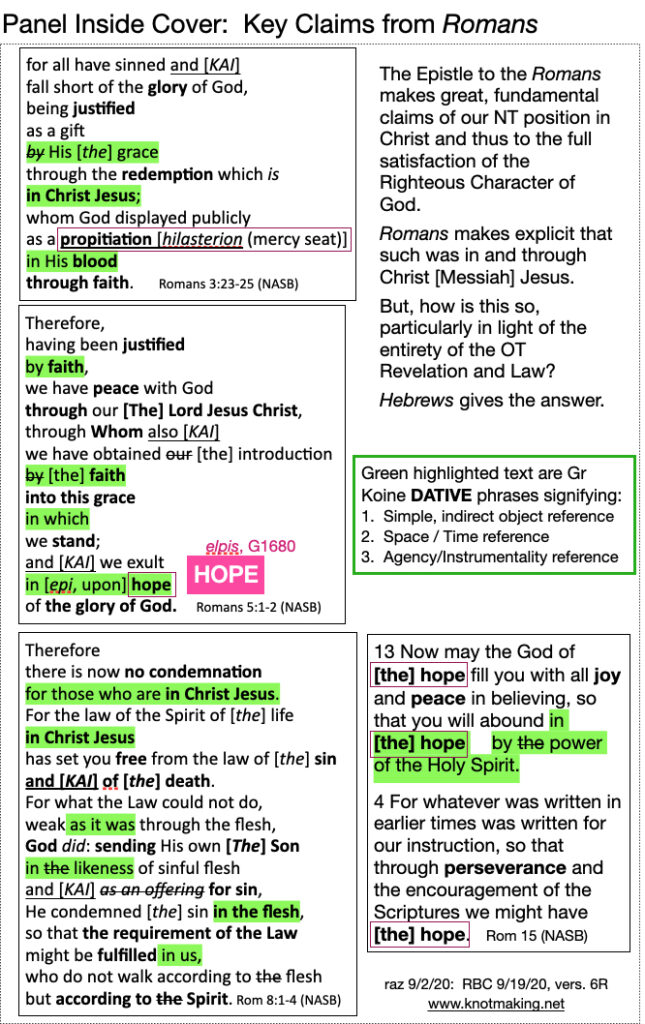This present study of the Book of Hebrews takes a different approach than done previously or any known commentary, of which they are an amazing number of wonderful ones (see John Owens, John Calvin, and Charles Hodge, just for starters).
The Three Cohering Threads of Hebrews
Here, we will consider the coherent whole of Hebrews following three, intertwined cords:
- The Person and Work of the Lord Jesus Christ, specifically with respect to effecting Propitiation (aka Redemption, Atonement, Justification, etc.)
- The Warnings
- Our Three Choices

Source Material
This study uses three documents:
- ESV Scripture Journal: Hebrews, booklet – published by Crossway, March 31, 2018
- 12 page / 24 panel PowerPoint-type document (I have done using Keynote),
- 4 page / 8 panel Appendix on the translation history of Hebrews 1:1-4 (also using Keynote)
Goals
We have three goals:
- See Hebrews whole, coherent. Verse-by-verse study, or chapter-a-day reading just doesn’t capture the big picture, the holistic message. Hebrews was certainly meant to be read straight through. But its deep study can only ‘work’ by constant reference to such overall context and key points.
- Acquire and use certain tools that will enable further self-study. Among these will be a mnemonic framed on the word “HOPE,” where “HO,” “P,” and “E” will be individually tagged with key words from our text. Further, there will be provided key word language study tools. The purpose of such tools is to aid in your lifelong delight in the continued study of Hebrews.
- Finally, and most-importantly, we seek to glorify Jesus Christ our God-Savior and Lord. This goal along with the one preceding are an expression of the answer to the first question of the Westminster Catechism, namely:
What is the chief end of man? A man’s chief end is to glorify God and enjoy His forever.
Principles of Study (Exegesis)
Following the principles of physical archaeology, we can apply them here to “exegesis” (extracting understanding from an ancient text) as follows:
- Determine the Provenance (Context)
- Next, The Dig (Study the text)
- Then, The Tale (Proclaim the teaching)
Here we want, briefly, to consider Step 1, the Provenance / Context of Hebrews. The authorship is not identified in the body of Hebrews. We will take it as an underdetermined human author (or authors) under the inspiration of the Holy Spirit, which makes it authoritative, and inerrant in our consideration.
We do not know to whom it was written in any specific sense as the Epistles known as Romans and Corinthians make explicit reference to its audience, as typical of other Epistles. Here even the words “Hebrew” or “Hebrews” do not occur. Nor is any location specified as to its initial delivery point. There is however strong evidence for a “not later than” date as (1) the destruction of Jerusalem and the Temple with its OT / Mosaic sacrificial practices is well known from extra-Biblical sources as 70 A.D., and (2) the many OT references in Hebrews to such Mosaic practice and its strong presumption that such were continuing at the time of its writing makes is as certain as these things can be that it was written prior to 70 A.D., which makes it likely to be before 66 A.D., as the revolutionary actions began in Israel at that time against Rome’s rule leading ultimately to the 70 A.D. destruction.
What specifically occasioned the writing? We don’t know, but here I will posit a reasoned guess, namely: that the powerful argument of the Epistle to the Romans necessitated an explanation (1) as to how, exactly, could the claim that we, as believers, are “in Christ” (said 10x in Romans), (2) as to what, exactly, was to be the continuing role of the Mosaic religious system. The image directly below is of several exemplary excerpts from Romans which when grasped lead us to the puzzle of “how can such things be?” especially given the the two plus millennium context of the massive OT.

(We will discuss later the significance of the highlighting and other annotations given above).
With further regard to the import of Romans, we have an intriguing recent (1925) mss discovery known as P46 or the Beatty Manuscript. As will be discussed later, it is indisputable that in such mss, which contains most of the NT Epistles, that of Hebrews begins immediately after Romans, even to the extent that end of Romans Ch 16 (in that mss) is at the top of the codex page (P46 was in codex, or book, form not as in the more ancient scroll form), of the opening page of Hebrews.
With regard to the second point, the post Resurrection role of the practices of the Mosaic Law, I will make clear in Part 2 below that such is the warnings of Hebrews, which warnings can be generalized as the practices of The Religion Industry (TRI), which TRI goes back to antiquity and extends to this present day and will until the very end of the Book of Revelation in its various guises, disguises, and forms.
Part 1: Coherent View of the Person and Work of Jesus Christ
Part 2: Warnings
Part 3: Choices
Below are two pdfs. The first one is comprised of 24 Panels corresponding to the identified pages in the ESV Journal Booklet published by Crossway. The second one is an appendix that drills down on the history of translation of Hebrews 1:1-4.
PDF 1, for use as Panels for ESV Journal Hebrews booklet, is below:
PDF 2, Appendix on additional discussion of Heb. 1:1-4, is below: